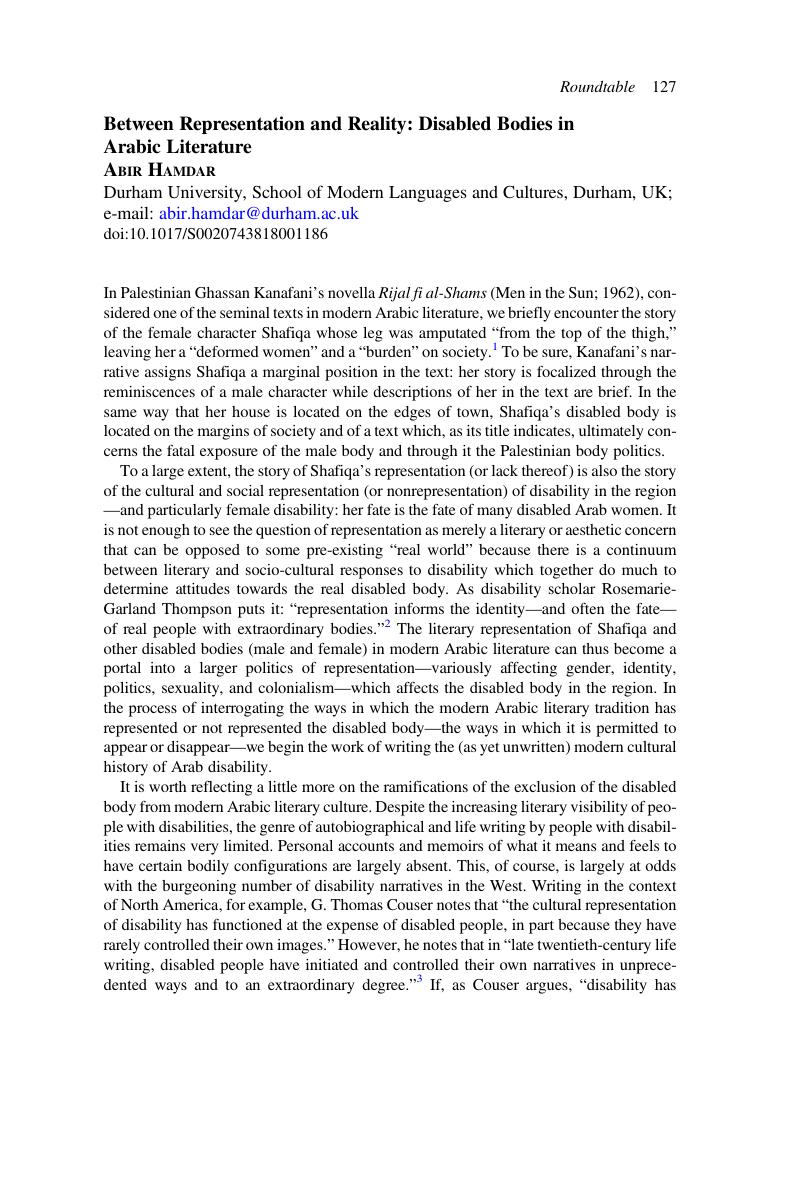Published online by Cambridge University Press: 14 January 2019

1 Kanafani, Ghassan, Men in the Sun and Other Palestinian Stories, trans. Kilpatrick, Hilary (London: Lynne Reinner Publishers, 1999), 64, 39–40Google Scholar.
2 Thompson, Rosemarie Garland, Extraordinary Bodies: Figuring Physical Disability in American Culture and Literature (New York: Columbia University Press, 1997), 15Google Scholar.
3 Couser, G. Thomas, “Disability, Life Narrative, and Representation,” in The Disability Studies Reader, ed. Davis, Lennard J., 4th ed. (London: Routledge, 2013), 399Google Scholar.
4 Couser, G. Thomas, Signifying Bodies: Disability in Contemporary Life Writing (Ann Arbor, Mich.: University of Michigan Press, 2009), 3CrossRefGoogle Scholar.
5 “Disability Rights in the Middle East & North Africa” (report by Sida, Stockholm, December 2014), accessed 18 September 2018, https://www.sida.se/globalassets/sida/eng/partners/human-rights-based-approach/disability/rights-of-persons-with-disabilities-mena.pdf.
6 Ibid.
7 See Husayn, Taha, al-Ayyam, 3 vols. (Cairo: Dar al-Maʿarif, 1978)Google Scholar.
8 Scalenghe, Sara, Disability in the Ottoman Arab World, 1500–1800 (New York: Cambridge University Press, 2014), 8CrossRefGoogle Scholar.
9 Daoud, Hassan, Makyaj Khafif li-Hadthahi al-Layla (Beirut: Dar Riad el-Rayess, 2004)Google Scholar.
10 Khedairi, Betool, Ghayib (Beirut: al-Muʾassasa al-ʿArabiya li-l-Dirasat wa-l-Nashr, 2004)Google Scholar.
11 Bitar, Haifaʾ, Imraʾa min Hadtha al-ʿAsr (Beirut: Dar al-Saqi, 2004)Google Scholar.
12 Yassin Refaʿiyah, “al-Ghiwaya fi Hudn al-Mawt,” al-Mustaqbal, 14 January 2004, accessed 18 September 2018, https://almustaqbal.com/article/45937/.
13 Bitar, Imraʾa, 102, 98. My translation.
14 Quoted in Diana Alghoul, “Fighting the Taboo of Disability in the Arab world,” MEMO: Middle East Monitor, 3 December 2016, accessed 18 September 2018, https://www.middleeastmonitor.com/20161203-fighting-the-taboo-of-disability-in-the-arab-world/.